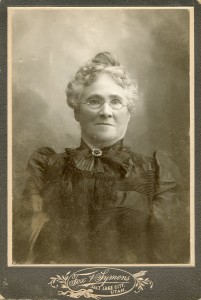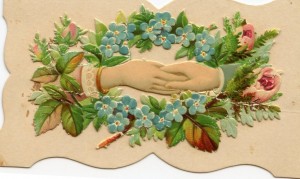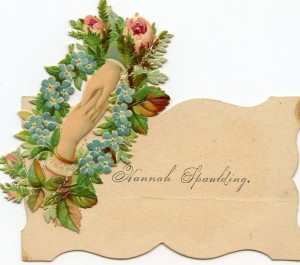First, the best perspective…
Be ye kind one to another… – Ephesians 4:32a
Ah – the difficulty of remembering names! Have you ever had to admit to someone, “Forgive me, but I forgot your name?” If you are like me, this is a regular occurrence and might happen several times with the same person, particularly when you see them infrequently. Well, there is really no need to feel bad, as many of us would admit
to at least occasional difficulties in these brief moments of social interaction with others. However, a social custom from long ago –
if revived – could truly help us overcome this difficulty.
During the 1800s, people used calling cards as a way of forming and building friendships with others. The custom began in France, spread through Europe, and then arrived in America by 1840 and became quite popular among middle and upper class society. The popularity in the United States peaked between about 1840 and 1900 before fading into obscurity.
The use of calling cards during these years was guided by decorum and very stringent guidelines. It was a social expectation that every properly cultured lady or gentleman would fully understand and follow these rules and traditions.
A man’s calling card was simple in its design, often having only his name, although in the later 1800s, his address was also included.
The card did not include an honorary title unless it was a military
rank or a professional title such as ‘Dr. James Smith’ or ‘James Smith M.D.’ The design was plain and the name was usually in ordinary block letters. Cards were carried in a case designed for the purpose.
Ladies’ calling cards were often larger than those used by men and also were simple in their design. In earlier times, the script was more basic, but in the latter years of the 19th century, the style became more elaborate.
The actual calling on ones friends, neighbors, and acquaintances also had clearly defined customs which were considered proper etiquette. These rules were part of one’s social graces and could be rather elaborate, especially when compared to today’s lack of formality. We no longer maintain such clearly defined social standards, but have you ever received a ‘poke’ on Facebook?
During the later 1800s, the following are but a few of the social customs regarding calling on people, which usually happened during the late afternoon hours – perhaps 3:00 – 5:00 PM. However, if the person was not at home, the visitor would leave his calling card for when the friend returned later and a corner of the calling card would be folded down to indicate the reason for the visit:
~ A visit in person (instead of a servant): Right hand upper corner
~ A congratulatory visit: Left hand upper corner
~ A condolence visit: Left hand lower corner
~ Taking leave (going on a trip): Right hand lower corner
A gentleman would also indicate a more specific reason with a set of initials from the French – similar to our RSVP which from the French is – répondez s’il vous plaît.
~ p. f. – pour feliciter (congratulations)
~ p. r. – pour remercier (expressing thanks)
~ p. c. – pour condoleance (expression of condolence)
~ p. f. N. A. – pour feliciter Nouvel An (Happy New Year)
~ p. p. c. – pour prendre conge (planning to leave on a trip)
~ p. p. – pour presenter (send your calling card to be introduced)
Now, please allow me to introduce Hannah Spaulding, my third great grandmother (1832-1909), who lived throughout the Victorian Age, and being from England, may have lived her life under the influence of formal English manners and customs.

Hannah Spaulding (1832-1909) – My 3rd Great Grandmother
Photo from collection of Jeff Michaels
Click on Photos to Enlarge
A small piece of evidence of this has survived more than 100 years, passed down through the generations – her personal calling card.
The example below is a typical ‘covered name’ calling card which
would be presented at the door of a home while out calling, or visiting.

Above: Hannah Spaulding’s Victorian Age calling card, as it would
be presented at the door of a home where she stopped for a visit.
Below: The Victorian ‘scrap’ would be lifted from the card, thus revealing the name of the presenter. An effective introduction!
Family History of Hannah Spaulding:
Andrew J. Cutter (1828/29- ?) = Hannah Blackburn (1834-1909)
(married abt. 1849)
Children:
1. Volney W. (1850-1912) = Isabella Phelps (1858-1915)
2. Henrietta (b. 1854/55) = __________ Tibbets
3. Frances E. (b. 1859/60) = Orlando Ward (1845-1928)
4. Clara = Patrick Weber
5. Marietta = __________ Ditman
Reuben Spaulding (1823-1903) = Hannah (Blackburn) Cutter
(married abt. 1865)
Children:
6. George F. (1866-1947) = Mary F. Warrick (1868-1955)
7. Julia (Lulu) (b. 1869) = __________ Whiting
8. James W. (1872-1955) = Sarah L. __________ (1872-1952)
9. William S. (1877-1920) = Alice F. __________ (b. 1881/82)
Ancestral Line:
6. Hannah (Blackburn) Cutter-Spaulding
5. Volney W. Cutter
4. Edna M. (Cutter) Lindsey
3. Edward J. Lindsey
2. Barbara J. (Lindsey) MIchaels
1. Jeffery J. Michaels

© Jeffery J. Michaels / Plain English Publications 2015
(Quotations allowed with attribution to this blog)

